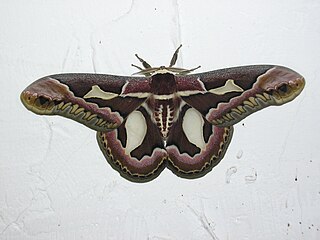
Alejandro José Luis Orfila was an Argentine career diplomat, who later became a prominent winemaker in San Diego, California.

Mathieu Joseph Bonaventure Orfila was a Spanish toxicologist and chemist, the founder of the science of toxicology.

The Stephanidae, sometimes called crown wasps, are a family of parasitoid wasps. They are the only living members of the superfamily Stephanoidea. Stephanidae has at least 345 living species in 11 genera. The family is considered cosmopolitan in distribution, with the highest species concentrations in subtropical and moderate climate zones. Stephanidae also contain four extinct genera described from both compression fossils and inclusions in amber.
Abnormipterus is a monotypic moth genus in the erebid subfamily Arctiinae described by Orfila in 1935. Its single species, Abnormipterus abnormis, was first described by George Hampson in 1898. It is found in the lower Amazon River basin.

Eurata is a genus of moths in the subfamily Arctiinae. The genus was erected by Gottlieb August Wilhelm Herrich-Schäffer in 1853.

Victrix is a genus of moths in the family Noctuidae described by Otto Staudinger in 1879. It may be synonymous with the genus Moureia.
Lepidojulia is a monotypic moth genus in the family Erebidae. Its only species, Lepidojulia arnaui, is found in the Tucumán Province of Argentina. Both the genus and species were first described by Orfila in 1952.
Pleurosoma is a genus in the moth subfamily Arctiinae described by Orfila in 1935.
Sphecops is a monotypic moth genus in the subfamily Arctiinae described by Orfila in 1935. Its single species, Sphecops arctata, was first described by Francis Walker in 1864. It is found in Brazil.
Moureia was erected as a moth genus by Ricardo N. Orfila and Nelida H. Rosisi in 1956. It is now considered by Butterflies and Moths of the World to be a synonym of VictrixStaudinger, 1879 and by Lepidoptera and Some Other Life Forms and The Global Lepidoptera Names Index to be a synonym of BryophilaTreitschke, 1825.

Rothschildia is a genus of moths in the family Saturniidae first described by Augustus Radcliffe Grote in 1896.

Alucita is the largest genus of many-plumed moths ; it is also the type genus of its family and the disputed superfamily Alucitoidea. This genus occurs almost worldwide and contains about 180 species as of 2011; new species are still being described and discovered regularly. Formerly, many similar moths of superfamilies Alucitoidea, Copromorphoidea and Pterophoroidea were also placed in Alucita.
Pedro Orfila Artime is a Spanish footballer who plays as a right-back or a central defender for Marino de Luanco.
Cissura bilineata is a moth of the family Erebidae first described by Orfila in 1935. It is found in Paraguay.
Vianania argentinensis is a moth of the family Erebidae first described by Rothschild in 1912. It is found in Argentina.
Vianania australis is a moth in the subfamily Arctiinae. It was described by Orfila in 1935. It is found in Argentina.
Vianania aymara is a moth in the subfamily Arctiinae. It was described by Orfila in 1954. It is found in Bolivia.

The Hypoptinae are a subfamily of the family Cossidae.

Acraga is a genus of moths of the family Dalceridae. The genus has neotropical distribution.
Acraga sexquicentenaria is a moth in the family Dalceridae. It was described by Ricardo Orfila in 1961. It is found in southern Brazil, northern Uruguay, and northern Argentina.








